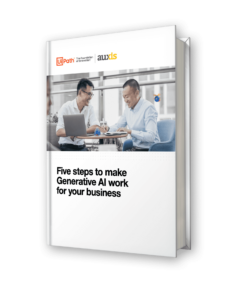In brief:
- Most enterprises today feel pressured to have an AI and Generative AI roadmap.
- Integrating generative AI can be transformative for businesses and provide real benefits right from implementation.
- The potential of generative AI can be fully realized only when it is combined with automation.
- Auxis is leveraging GenAI to accelerate and improve communications/ interactions between vendors and clients, enable easier knowledge management, and create LLM-powered chatbots to provide more human-like responses.
Generative Artificial Intelligence (GenAI) has undoubtedly been one of the most talked about technologies in recent years. Since bursting into popular imagination with OpenAI’s ChatGPT chatbot just over a year ago, GenAI has been called a technological breakthrough which could have dramatic effects worldwide in the near future, including transforming and enhancing how people work, causing widespread job losses, and adding trillions of dollars in value to the global economy, based on a recent McKinsey survey.
While these might well be true, today most enterprises are trying to figure out how they can leverage this “miracle technology” for immediate benefits. The pressure to put in place an AI and GenAI strategy and implementation roadmap is resonating across boardrooms worldwide. This blog addresses these pressing issues and shares how Auxis, a leader in IT and digital transformation, perceives the benefits of Generative AI and how it can be leveraged today by enterprises and smaller businesses.
What is GenAI?
Artificial Intelligence uses predefined rules and algorithms to perform a range of functions such as generating insights, automation of repetitive tasks, and predicting trends, all within the boundaries of existing data and expected outcomes. GenAI takes this technology further, as it is capable of learning from existing artifacts enhance content creation or create new content from scratch, such as images, text, and other media, reflecting the characteristics of the training data but not repeating it.
Two of the most widely used generative AI models today are:
- Generative Adversarial Networks (GAN): A deep learning architecture that trains two neural networks to compete against each other to generate more authentic new data from a given training dataset. These are most commonly used for generating realistic images or editing existing images through text-based prompts or by modifying existing images.
- Transformer-based models: These models can analyze large data sets at scale to automatically create large language models (LLMs). The best example of an LLM is OpenAI’s Generative Pre-trained Transformer (GPT) series which powers ChatGPT.
The language processing skills and general reasoning abilities of LLMs have made it the most popular GenAI model among the growing number of organizations taking their first steps in deploying this technology.
Benefits of generative AI for business
For businesses, the potential of implementing generative AI tools can be fully realized only when it is combined with automation GenAI takes the capabilities of automation technologies such as Robotic Process Automation (RPA), machine learning, and Intelligent Document Processing (IDP) several steps forward, helping them leverage AI-powered insights to perform business process tasks based on existing data patterns and by continuously fine-tuning their parameters. With enhanced decision making, adaptability and learning, combining generative AI and machine learning is enabling traditional RPA to deliver improved efficiency and accuracy with minimal human intervention as well as automation of complex tasks, including a wider range of business processes.
Below are some of the ways integrating generative AI can be transformative for businesses and provide real benefits right from implementation.
1. Pre-Trained models for faster time-to-value
The path-breaking aspect of GenAI is that these models are pre-trained on massive sets of data, giving them a strong foundation of knowledge and patterns to draw from, even before you start working on them. This is a complete departure from how AI was previously trained, which involved investing months of prework and, depending on the use case, millions of dollars, for data scientists to prepare data, define rules and processes, and train and program the AI model to produce accurate and reliable outcomes.
For instance, for an Intelligent Document Understanding (IDU) solution to understand the termination clauses on 100 documents, each document needed to be tagged and keywords identified so the IDU model could locate the required information. In short, it needed to be trained with specific information to execute this task.
Generative AI models, being pre-trained, enhance and accelerate the classification and pre-labeling to shorten training times of IDU models, resulting in speedier implementations and faster time-to-value for clients. With GenAI, you can simply input the 100 documents you need to understand termination clauses for, and it will find the required information from them, extract it, and summarize it, with a high level of accuracy.
The models can also be continuously retrained with company-specific data, meaning the more you work with the model, the more effective it becomes, and the accuracy of the output improves over time. This level of ease had, till now, been impossible with traditional AI.
2. Improved decision-making for enhancing automation
GenAI brings a new level of judgement skills, empowering decision-based automation, such as RPA, for processing both structured data (data that can be stored in structured databases, e.g., numbers, short text, and dates) and unstructured data (which cannot fit into a data table because of its size or nature, e.g. web pages, customer emails, video files, etc.).
Until now, it was very difficult to build automations for processing unstructured data. Unlike for structured data, where specific rules can be built to guide automations, the lack of a predetermined data model, or schema, meant rules-based automation was not possible for processing unstructured data. Judgment skills, contextual awareness, and decision-making ability were required, and that was possible only with human intervention. This meant that several business requirements simply could not be built into automation as adapting to unexpected scenarios would require frequent rule adjustments.
With GenAI models equipped with advanced Natural Language Processing (NLP) capabilities, such as GPT-3, the technology can understand and interpret human language, enabling categorization, analysis, and extraction of insights from unstructured data. These models also adapt and learn from experience to handle a broader range of exceptions and variations. This enables true end to end automation of tasks, including those involving unstructured data, and is helping businesses derive more value from their data.
3. Sentiment and intent analysis
GenAI models, particularly those designed for natural language understanding, are also able to correctly comprehend sentiment and intent, through a combination of pre-training and fine-tuning processes. This is an extremely powerful capability. Understanding context, intent, and tone, and being able to answer with those similar attributes, is set to revolutionize numerous business use cases across various industries.
4. Ability to integrate company-specific information, with guardrails
While LLMs are pre-trained on large datasets on general knowledge and language-based interaction, they can be made more useful by integrating proprietary data to perform specific tasks. This can be done by fine-tuning the LLM either by adjusting some parameters of the model for adding specific domain content, or through prompt tuning, i.e., giving the LLM prompts that contain domain-specific knowledge.
These models can be configured with safeguards to control their behavior, ensuring that they operate within the boundaries defined by the organization. This is particularly important when dealing with private corporate information to maintain data privacy, prevent leaks, and safeguard proprietary information from misuse. Hence, any organization considering using GenAI needs to establish controls and guidelines to harness the benefits of AI while managing the associated risks effectively.

Business use cases for generative AI today
Generative AI capabilities for businesses are increasing every day as technology advances rapidly. However, how businesses can leverage it varies widely depending on their size, industry, and stage of digital transformation.
Below we detail business use cases of GenAI that Auxis has identified for organizations, and that we are implementing with clients:
- Accelerating and improving communications/ interactions between vendors and clients: GenAI-powered RPA bots to handle interaction between vendors and clients seamlessly, effectively, and in real time. This includes laborious and complicated business tasks such as customer service interactions, answering account payable queries, processing purchase orders, etc. This can help businesses free up resources in their accounts payable department while dramatically reducing delays in payment processing and accelerating dispute resolution.
Auxis recently leveraged ChatGPT for customer service by integrating RPA with GenAI to handle customer reviews for a major property management company, building a 100% automated solution for composing and posting responses to reviews on Google and TripAdvisor. - Easier knowledge management: Pre-trained Machine Learning models enhance classification and pre-labeling of data, shortening the training times of IDU solutions. This makes it possible to process unstructured documents and simplifies retrieving information from complex long form documents like contracts or financial statements. All with a much higher rate of accuracy from Day 1. This enables faster implementation of the solution and faster time-to-value for clients.
- LLM-powered chatbots to give more human-like responses: LLM-powered chatbots leverage advanced natural language understanding to produce human like conversations, enabling them to comprehend and respond to user queries with a similar level of nuance and understanding. This helps in optimizing customer support and increases operational efficiency. More importantly, it contributes to a more seamless user experience through faster resolution and helps reduce frustration and increasing customer satisfaction, unlike the more basic chatbots which could not recognize intent or context and would keep taking customers through the same set of menu options in a loop.
As businesses of all sizes experiment and discover new use cases and benefits of GenAI every day, its potential impact is undeniable. However, the journey toward integrating GenAI into your everyday business operations should be a strategic move taking into consideration not only the immediate gains in efficiency, productivity, and customer experience but the careful alignment of AI initiatives with your overarching business objectives and growth strategies.
Auxis is leveraging our expertise as an experienced automation practitioner and a long-time UiPath partner to ensure our clients get the most cutting-edge technology, skilled resources, and support for their automation journey. Learn more about it here.




